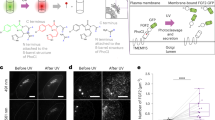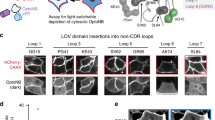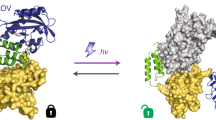Abstract
We present a versatile platform to inactivate proteins in living cells using light, light-activated reversible inhibition by assembled trap (LARIAT), which sequesters target proteins into complexes formed by multimeric proteins and a blue light–mediated heterodimerization module. Using LARIAT, we inhibited diverse proteins that modulate cytoskeleton, lipid signaling and cell cycle with high spatiotemporal resolution. Use of single-domain antibodies extends the method to target proteins containing specific epitopes, including GFP.
This is a preview of subscription content, access via your institution
Access options
Subscribe to this journal
Receive 12 print issues and online access
$259.00 per year
only $21.58 per issue
Buy this article
- Purchase on Springer Link
- Instant access to full article PDF
Prices may be subject to local taxes which are calculated during checkout



Similar content being viewed by others
References
Doupé, D.P. & Perrimon, N. Sci. Signal. 7, re1 (2014).
Turgeon, B. & Meloche, S. Physiol. Rev. 89, 1–26 (2009).
Stockwell, B.R. Nature 432, 846–854 (2004).
Zhou, P. Curr. Opin. Chem. Biol. 9, 51–55 (2005).
Banaszynski, L.A., Maynard-Smith, L., Chen, L.C. & Wandless, T.J. Chem. Biol. 13, 11–21 (2006).
Wu, Y.I. et al. Nature 461, 104–108 (2009).
Levskaya, A., Weiner, O.D., Lim, W.A. & Voigt, C.A. Nature 461, 997–1001 (2009).
Kennedy, M.J. et al. Nat. Methods 7, 973–975 (2010).
Bugaj, L.J., Choksi, A.T., Mesuda, C.K., Kane, R.S. & Schaffer, D.V. Nat. Methods 10, 249–252 (2013).
Lee, S., Lee, K.H., Ha, J.S., Lee, S.G. & Kim, T.K. Angew. Chem. Int. Edn. 50, 8709–8713 (2011).
Rosenberg, O.S., Deindl, S., Sung, R.J., Nairn, A.C. & Kuriyan, J. Cell 123, 849–860 (2005).
Liu, H.T. et al. Science 322, 1535–1539 (2008).
Lee, K.H., Lee, S., Lee, W.Y., Yang, H.W. & Heo, W.D. Proc. Natl. Acad. Sci. USA 107, 3412–3417 (2010).
Aoki, K., Nakamura, T., Fujikawa, K. & Matsuda, M. Mol. Biol. Cell 16, 2207–2217 (2005).
Riedl, J. et al. Nat. Methods 5, 605–607 (2008).
Misawa, K. et al. Proc. Natl. Acad. Sci. USA 97, 3062–3066 (2000).
Matsuyama, A. et al. Nat. Biotechnol. 24, 841–847 (2006).
Huh, W.K. et al. Nature 425, 686–691 (2003).
Rothbauer, U. et al. Nat. Methods 3, 887–889 (2006).
Jordan, M.A. & Wilson, L. Nat. Rev. Cancer 4, 253–265 (2004).
Held, M. et al. Nat. Methods 7, 747–754 (2010).
Yang, X., Jost, A.P.-T., Weiner, O.D. & Tang, C. Mol. Biol. Cell 24, 2419–2430 (2013).
Shen, K. & Meyer, T. J. Neurochem. 70, 96–104 (1998).
Campbell, R.E. et al. Proc. Natl. Acad. Sci. USA 99, 7877–7882 (2002).
Heo, W.D. & Meyer, T. Cell 113, 315–328 (2003).
Livet, J. et al. Nature 450, 56–62 (2007).
Yang, H.W. et al. Mol. Cell 47, 281–290 (2012).
Kaech, S. & Banker, G. Nat. Protoc. 1, 2406–2415 (2006).
Acknowledgements
We thank C.L. Tucker (University of Colorado) for cDNAs encoding CRY2PHR-mCherry and CIBN-pmEGFP, T. Inoue (Johns Hopkins University) for cDNA encoding YFP-PHBtk and M. Matsuda (Kyoto University) for cDNA encoding Raichu-Rac1. This work was supported by the National Research Foundation of Korea Stem Cell Program (no. 2011-0019509), the Intelligent Synthetic Biology Center of Global Frontier Project (no. 2011-0031955) and the Korea Advanced Institute of Science and Technology Future Systems Healthcare Project funded by the Ministry of Science, Information and Communication Technology & Future Planning in Korea.
Author information
Authors and Affiliations
Contributions
W.D.H. and S.L. conceived the idea and directed the work. S.L., H.P., T.K., N.Y.K., S.K. and J.K. performed experiments. W.D.H., S.L., H.P. and T.K. wrote the manuscript.
Corresponding author
Ethics declarations
Competing interests
The authors declare no competing financial interests.
Supplementary information
Supplementary Text and Figures
Supplementary Figures 1–22, Supplementary Table 1 and Supplementary Note (PDF 9325 kb)
Rapid and reversible cluster formation upon blue-light illumination.
A HeLa cell co-expressing CRY2-mCherry and CIB1-mCerulean-MP was briefly stimulated by blue light (488 nm, 6.5 μW). Fluorescent images of CRY2-mCherry were captured in every 20 seconds. Numbers indicate minutes:seconds. (AVI 2742 kb)
Spatiotemporal control of cluster formation in multiple cells upon blue-light illumination.
Three HeLa cells co-expressing CRY2-mCherry and CIB1-mCerulean-MP were sequentially stimulated by blue light (488 nm, 6.5 μW for each cell) at different time points indicated by arrows. Fluorescent images of CRY2-mCherry were captured in every 20 seconds. Numbers indicate minutes:seconds. (AVI 3993 kb)
Spatiotemporal control of cluster formation at the subcellular level upon blue-light illumination.
Three different regions (12 μm in diameter) of a HeLa cell were sequentially stimulated by blue light (488 nm, 6.5 μW for each region) indicated by white-lined circles. Fluorescent images of CRY2-mCherry were captured in every 20 seconds. Numbers indicate minutes:seconds. (AVI 2960 kb)
Reversible inactivation of Vav2 visualized by cell morphological changes.
A NIH3T3 cell co-expressing mCherry-Lifeact, mCitrine-CRY2-Vav2, and CIB1-mCerulean-MP was stimulated twice by blue light (488 nm) at a 20-minute interval. Fluorescent images of mCherry-Lifeact were captured in every 20 seconds. Numbers indicate minutes:seconds. (AVI 5386 kb)
Inactivation of Vav2 in numerous cells in a wide field of view.
NIH3T3 cells co-expressing mCherry-Lifeact, mCitrine-CRY2-Vav2, and CIB1-mCerulean-MP were stimulated by blue light (488 nm). Fluorescent images of mCherry-Lifeact were captured in every 20 seconds. Numbers indicate minutes:seconds. (AVI 4714 kb)
Spatiotemporal inactivation of Vav2 at the subcellular level.
A NIH3T3 cell co-expressing mCherry-Lifeact, mCitrine-CRY2-Vav2, and CIB1-mCerulean-MP was stimulated by blue light (488 nm). Fluorescent images of mCherry-Lifeact were captured in every 20 seconds. Numbers indicate minutes:seconds. (AVI 2934 kb)
Changing cell polarity through local and sustained inactivation of Vav2.
A small region (indicated by yellow circles) of a NIH3T3 cell co-expressing mCherry-Lifeact, mCitrine-CRY2-Vav2, and CIB1-mCerulean-MP was repeatedly illuminated by blue light (488 nm) at 2-minute intervals for 46 minutes. Fluorescent images of mCherry-Lifeact were captured in every 20 seconds. Numbers indicate minutes:seconds. (AVI 8119 kb)
Inactivation of GFP-Vav2 by cluster-trapping with a CRY2-conjugated anti-GFP nanobody.
NIH3T3 cells co-expressing mCherry-Lifeact, CLIP-CRY2-VHH(GFP), CIB1-SNAP-MP, and EGFP-Vav2 were exposed to blue light (488 nm). Fluorescent images of mCherry-Lifeact were captured in every 20 seconds. Numbers indicate minutes:seconds. (AVI 2968 kb)
Inactivation of GFP-Tiam1 by cluster-trapping with a CRY2-conjugated anti-GFP nanobody.
NIH3T3 cells co-expressing mCherry-Lifeact, CLIP-CRY2-VHH(GFP), CIB1-SNAP-MP, and EGFP-Tiam1 were exposed to blue light (488 nm). Fluorescent images of mCherry-Lifeact were captured in every 10 seconds. Numbers indicate minutes:seconds. (AVI 3713 kb)
Inactivation of GFP-Rac1 by cluster-trapping with a CRY2-conjugated anti-GFP nanobody.
NIH3T3 cells co-expressing mCherry-Lifeact, CLIP-CRY2-VHH(GFP), CIB1-SNAP-MP, and EGFP-Rac1 were exposed to blue light (488 nm). Fluorescent images of mCherry-Lifeact were captured in every 10 seconds. Numbers indicate minutes:seconds. (AVI 3371 kb)
Inactivation of GFP-RhoG by cluster-trapping with a CRY2-conjugated anti-GFP nanobody.
NIH3T3 cells co-expressing mCherry-Lifeact, CLIP-CRY2-VHH(GFP), CIB1-SNAP-MP, and EGFP-RhoG were exposed to blue light (488 nm). Fluorescent images of mCherry-Lifeact were captured in every 10 seconds. Numbers indicate minutes:seconds. (AVI 2376 kb)
Inactivation of GFP-Cdc42 by cluster-trapping with a CRY2-conjugated anti-GFP nanobody.
NIH3T3 cells co-expressing mCherry-Lifeact, CLIP-CRY2-VHH(GFP), CIB1-SNAP-MP, and EGFP-Cdc42 were exposed to blue light (488 nm). Fluorescent images of mCherry-Lifeact were captured in every 10 seconds. Numbers indicate minutes:seconds. (AVI 4269 kb)
Inactivation of CFP-PI3KCAAX visualized by dissociation of PIP3 biosensor from the plasma membrane.
NIH3T3 cells co-expressing mCherry-PHBtk, CLIP-CRY2-VHH(GFP), CIB1-SNAP-MP, and ECFP-p110CAAX were exposed to blue light (488 nm). Fluorescent images of mCherry-PHBtk were captured in every 10 seconds. Numbers indicate minutes:seconds. (AVI 1210 kb)
Inactivation of CFP-PI3KCAAX visualized by cell morphological changes upon cluster-trapping with a CRY2-conjugated anti-GFP nanobody.
NIH3T3 cells co-expressing mCherry-Lifeact, CLIP-CRY2-VHH(GFP), CIB1-SNAP-MP, and ECFP-p110CAAX were exposed to blue light (488 nm). Fluorescent images of mCherry-Lifeact were captured in every 10 seconds. Numbers indicate minutes:seconds. (AVI 6245 kb)
Inhibition of microtubule function in the course of mitosis.
HeLa cells co-expressing mCherry-H2B and GFP-tubulin with CIB1-MP (the left video) or CRY2-VHH(GFP) (the center video) or both CRY2-VHH(GFP) and CIB1-MP (the right video) were exposed to blue light (488 nm) at 5-minute intervals for 24 hours. Fluorescent images of mCherry-H2B and GFP-tubulin were simultaneously captured in every 5 minutes. Numbers indicate hours:minutes. (AVI 23919 kb)
Rights and permissions
About this article
Cite this article
Lee, S., Park, H., Kyung, T. et al. Reversible protein inactivation by optogenetic trapping in cells. Nat Methods 11, 633–636 (2014). https://doi.org/10.1038/nmeth.2940
Received:
Accepted:
Published:
Issue Date:
DOI: https://doi.org/10.1038/nmeth.2940
This article is cited by
-
A platform to induce and mature biomolecular condensates using chemicals and light
Nature Chemical Biology (2024)
-
Direct investigation of cell contraction signal networks by light-based perturbation methods
Pflügers Archiv - European Journal of Physiology (2023)
-
The emergence of molecular systems neuroscience
Molecular Brain (2022)
-
Spatiotemporal control of necroptotic cell death and plasma membrane recruitment using engineered MLKL domains
Cell Death Discovery (2022)
-
Rapid and reversible optogenetic silencing of synaptic transmission by clustering of synaptic vesicles
Nature Communications (2022)



